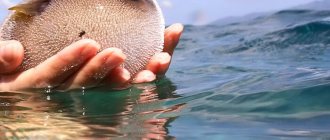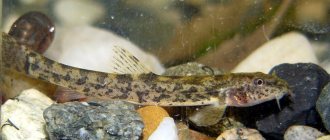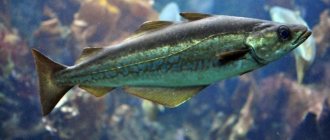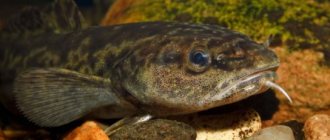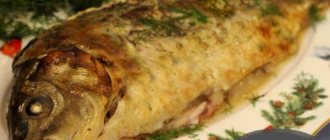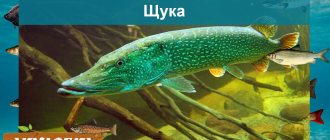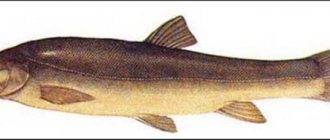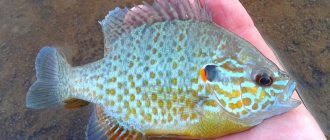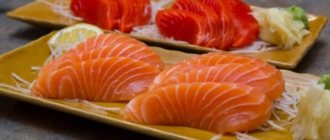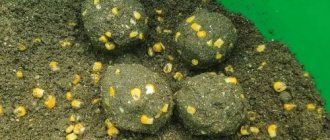Common features and differences
All representatives of this family have common features:
- disproportionately large head;
- large eyes;
- a light longitudinal stripe running along the body;
- there are no spiny rays in the fins;
- the presence of large gill openings;
- the body is covered with small cycloid scales.
Some codfish have a fleshy barbel located on the lower jaw. The body of some species is decorated with spots of various shapes and sizes.
Habitats
All codfish, except burbot, live in the seas. Burbot feels great in rivers and other freshwater bodies. Codfish inhabit the waters of the northern hemisphere; five of their species live in the seas of the southern hemisphere.
Most cod are found in the eastern part of the Atlantic, the Norwegian and Barents Sea. One cod thrives in the waters of the Baltic Sea.
Representatives of the family are found in the Mediterranean and Black Sea. Three species of this order live off the coast of New Zealand, South Africa, and South America.
Diet
Fish from the order Codfish are mostly predators. When young, they feed on bottom-dwelling invertebrates. These are crustaceans, worms, shrimp.
The codfish are growing and their diet is changing. It is now based on small fish. Often the prey of codfish are small representatives of their own family.
Thus, cod happily feeds on young pollock, and haddock actively eats blue whiting. Small representatives of the order, which include cod and gadiculus, are also predators.
The basis of their diet is plankton and benthonic crustaceans. But they try to diversify the menu, including fry and caviar of representatives of their squad. Cod fish are known for their cannibalism; adults happily eat their own young.
Useful properties of cod fish
Benefits of cod liver
Cod liver is the subject of controversy among many doctors and nutritionists. One part of people defines it as an offal, and the other – as a delicacy dish. However, the benefits of cod are undeniable, since healthy fish oil is prepared from it. The product itself has a fairly high nutritional value, and if properly preserved it will delight you with its unsurpassed taste.
The benefits of cod liver are also due to the fact that it does not undergo heat treatment at any stage of production. It arrives on the shelves in its raw form, so it does not lose any beneficial properties. The most important and beneficial element of cod liver is Omega 3, which plays an integral role in the normal functioning of the body.
Benefits of cod caviar
The beneficial properties of cod caviar were discovered in ancient times. The quality of cod caviar is in no way inferior to the expensive versions of red and black sturgeon caviar. It is actively used in cooking to prepare tasty and healthy dishes.
The most unique component in cod caviar is the Omega 3 group of amino acids. In addition, the fish contains natural antioxidants, the regular use of which has a positive effect on the health of teeth, skin and hair, and also strengthens the immune system and nervous system.
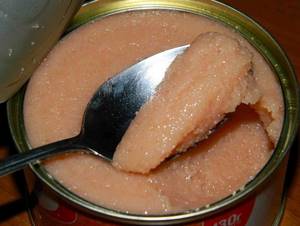
There are a wide variety of cod caviar options on store shelves, which are affordable and contain all the necessary vitamins and minerals.
Spawning
Most codfish are adapted for laying eggs in salty sea water. Inhabitants of northern latitudes try to choose desalinated areas of the reservoir for reproduction.
There are species that leave the seas during spawning and go into rivers. Many codfish are considered sexually mature after 3 years of life, others begin to spawn only at 8-10 years.
Representatives of the family lay eggs without interruption for several years in a row. During one spawning, several million eggs are laid. But not everyone does this; for example, navaga has much fewer eggs - only a few thousand.
The spawning period is winter, or the end of winter. The water temperature during spawning is within 0 degrees. The emerging fry have two options - to stay in place, or with the help of the current to move across the waters of the seas and oceans.
Codfish are great travelers; they migrate throughout their lives. Their movements depend on natural factors - currents, food supply, water temperature.
Spawning and reproduction
Most cod fish reach sexual maturity by 3–5 years , but some of them, including ordinary cod, go to their first spawning only 8–10 years after birth. It occurs in late winter or early spring, when the air temperature is approximately 0 °C, and lasts for several days. The fertility of different members of the family differs significantly : they can lay from several thousand to several million eggs.
In connection with spawning, many cod species migrate to new habitats - northern species, for example, enter desalinated water, and some even into river mouths. The fry of these fish, having barely hatched, already begin to spread over long distances by sea and ocean currents. The young of some species, such as haddock, use the tentacles of jellyfish as protection from enemies.
Types of cod fish
Pacific cod

The average size is 40-80 cm, can grow up to 1.2 m. It is found in the Sea of Okhotsk, the Sea of Japan, and the Bering Sea, without long migrations. It has a very large head, begins to spawn in the fifth year, and lays millions of eggs. Life expectancy is up to 12 years.
Up
Atlantic cod
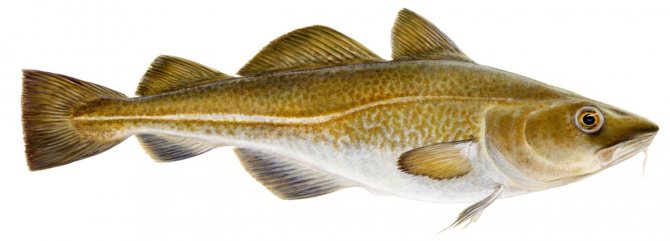
This species is listed in the International Red Book and the Red Book of Russia. The average size of cod is 30-70 cm, there are individuals reaching 1.8 m. It is a predator; cod begins laying eggs at 8-10 years of age. It is considered very valuable because of its meat and liver.
Up
Saida
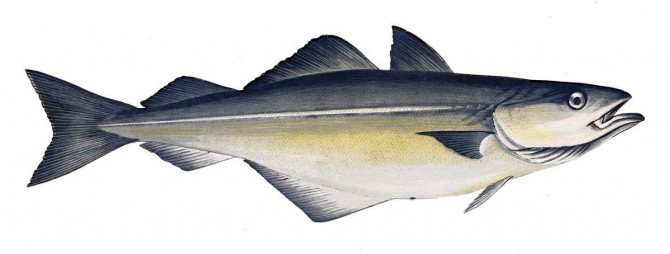
Pollock is a schooling fish. Habitat: water column in the North Atlantic, may be near the bottom. The average size is 70 cm, can grow up to a meter. Migrates long distances in search of cool water. This is a beautiful fish that tastes like salmon.
Up
Southern blue whiting

The maximum size of a fish is 0.5 m, and its weight reaches 1 kg. In the waters of the southern hemisphere it prefers to stay close to the surface of the water. Migrating from these places, it climbs to a depth of 0.5 km. Southern blue whiting is caught on an industrial scale.
Up
Northern whiting
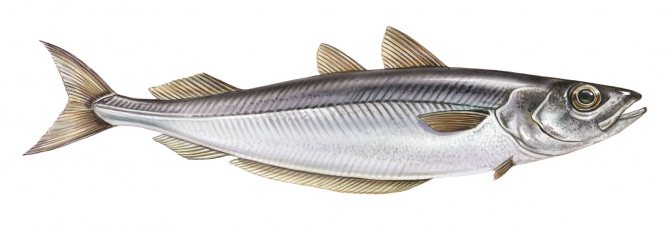
It grows slowly, the maximum length of the body is 50 cm, the average length is 35 cm. This predator, in addition to plankton, feeds on fry and small crustaceans. Northern blue whiting is caught on an industrial scale. The fish is found in the northeastern Atlantic, its habitat depth is 30-800 meters.
Up
Pollock
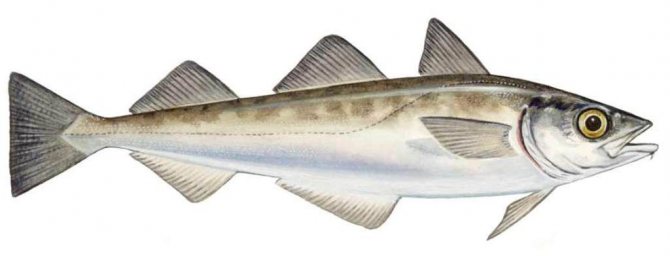
Habitat: North Pacific Ocean, pollock loves cold water, the temperature of which ranges from 2 to 9 degrees. It stays at a depth of 0.5 km and comes out to shallow water during the spawning period. It spawns after 3-4 years of life. Can grow up to 50 cm in length.
Up
Haddock
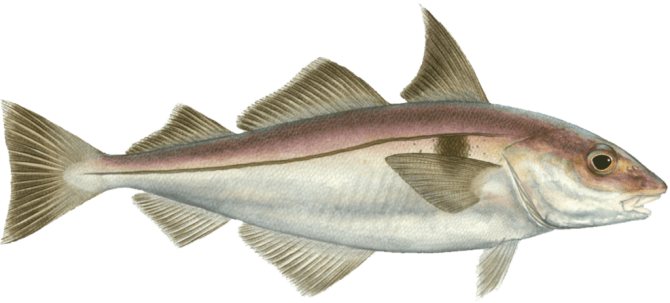
The body of haddock is compressed laterally, the fish lives closer to the bottom. The color of her body is silver, it is decorated with a black lateral line, the same spot located above the pectoral fin. The usual size of haddock is 60-70 cm. In addition to mollusks, worms, crustaceans, it loves herring caviar. They spawn at 3-5 years of age. It lives in the waters of the North Atlantic, and is fished in the North and Barents Sea.
Up
Burbot
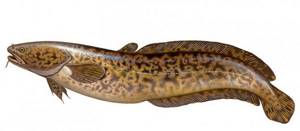
Lives in rivers and lakes of Asia, Europe, America. In Siberia, trapping is carried out on an industrial scale. It leaves for spawning in winter, when the reservoir is covered with ice. This is a nocturnal fish that does not like sunlight. Its average size is 60 cm, weight is one and a half kg. Some individuals can grow up to 1 meter, then their weight exceeds 20 kg.
Up
Northern navaga
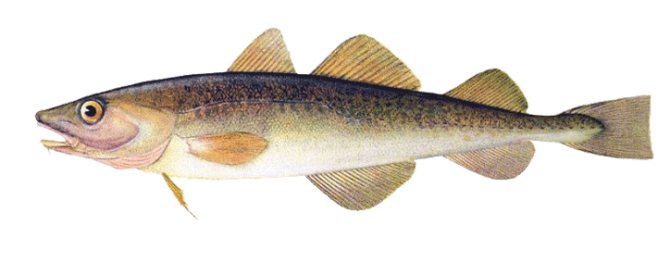
Inhabits the coastal zone of the Kara, Pechora, and White Seas. It may go into rivers to spawn. In this case, the process of spawning occurs only in salt water, in winter, at a depth of up to 10 m. The eggs stick to the bottom, the fry develop for 4 months. The average length of the fish is 35 cm.
Up
Far Eastern navaga

This is an inhabitant of the northern waters of the Pacific Ocean, the Sea of Okhotsk, the Chukchi Sea, and the Sea of Japan. The average length is 35 cm, there are individuals reaching half a meter in length. Spawning begins at 2-3 years of age, in winter. During normal periods of life, it prefers to be in the coastal zone.
Up
Word of mouth

Leads a bottom-dwelling lifestyle. The average length of the moth is 1 m, there are individuals that grow up to 2 m. This is a predator, feeds only on living organisms, and is very fond of small fish. Spawning begins at 8-10 years of age.
Up
Whiting
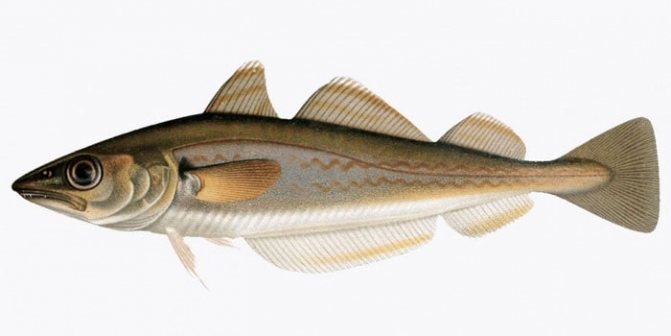
Habitat: the waters of the Atlantic, Mediterranean, and the coast of Europe. On the coast of Crimea, whiting is carried into the Black Sea by the current after storms. The average length is 0.5 m. It is a predator, feeds on crustaceans and fish. Spawning begins at 2 years of age.
Up
Gadikul

The second name for the gadikula is “big-eyed cod.” The depth of its habitat is up to 1 km. The size of the eyes is equal to 1/3 of the head. The fish grows up to 12 cm, the largest specimens are up to 15 cm. It is found in Northern Norway and the Mediterranean.
Up
Cod fish: list
Below, each of the popular representatives of this fish will be described in more detail:
Gadikul

Another name for big-eyed cod. It is located at a depth of up to a kilometer. A distinctive feature is its large eyes, for which it received its second name. The maximum size is only 15 centimeters. You can meet this fish in Norway.
Gadikul happens:
- Northern;
- South.
Let's celebrate! There is no big difference in appearance, but they differ in the set of fins.
Men

Ray-finned fish. Most common in the Atlantic Ocean. The appearance is yellow-brown in color and there is a line on the body that starts from the head and ends at the tail. The maximum weight of a mature little one is 30 kilograms.
Whiting

It lives in the Atlantic, but sometimes this fish can be found in the Crimea. The length can reach 60 centimeters. The first spawning occurs only 2 years after birth; for successful reproduction, it selects cold water. It feeds on fry and other small sea inhabitants. Stays close to the surface. He is afraid of dolphins and other large predators that might eat him.
Pollock
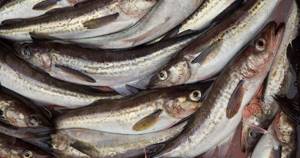
A valuable representative of cod, commercial fishing not only for fish, but also for its liver. Lives in the Pacific Ocean at a depth of up to 1000 meters; when the water is warm, it can migrate to other cold places. It breeds at 4 years of age, both in summer and winter.
Word of mouth

Predatory fish. Practically does not rise to the surface. The minimum length is 1 meter, the maximum is 2 meters. Consumes all inhabitants of the water that are smaller than it. It breeds only at 9 years of age.
Far Eastern navaga
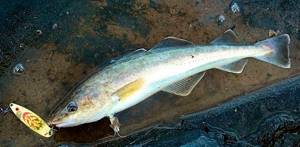
Lives in many countries of the Far East. The length of the fish is 25 - 60 centimeters. The entire period of the year is located near the coast, but with the onset of summer it swims away in search of food. Maturation for spawning occurs as early as 2 years and occurs only in winter, when the water temperature drops to sub-zero temperatures.
Northern navaga
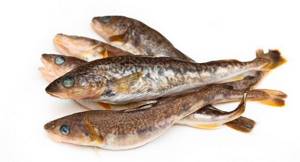
Marine inhabitant of the cod family.
Lives in such seas as:
- Pechora;
- Karskoe;
- White.
Let's celebrate! You can see northern navaga near the shore, but for breeding it moves to a depth of 10 meters. The size can reach up to 50 centimeters. Eats small fish and worms.
Common burbot
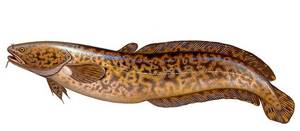
The only breed of cod that can live in Europe and Asia. It grows and develops safely in cold and clean water, with the presence of stones. In the spring it goes into hibernation and returns to its normal rhythm only in the fall.
Before breeding, it feeds a lot. Burbot does not tolerate sunlight and is active only at night. The body length reaches 12 meters, and the weight is 20 kilograms. It feeds on larvae and other small neighbors.
Haddock
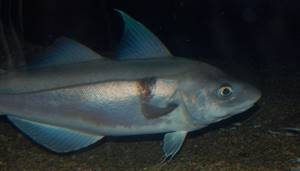
Lives in the Arctic Ocean. The color of the haddock is silver, and the line on the side is black. Body length – 70 centimeters. It grows by eating worms and herring eggs. The first spawning occurs already at 3 years. Every year the catch amounts to almost a million pieces.
Northern whiting
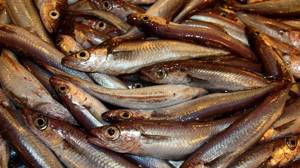
Smaller in size than the southern one and weighs only 0.5 kilograms. A feature may be the absence of an antennae. Lives at a depth of 800 meters.
Southern blue whiting
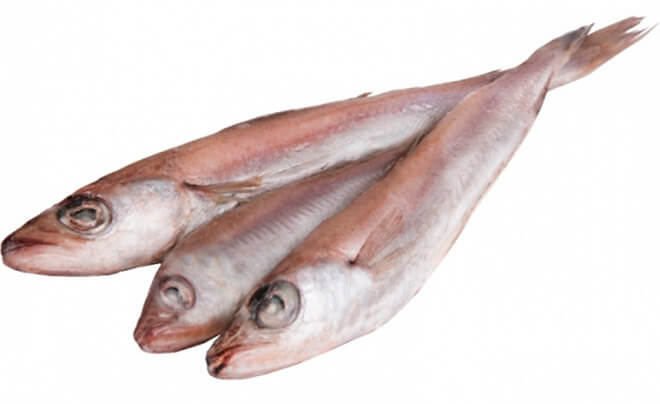
Up to half a meter in size and up to a kilogram in weight. The Pacific Ocean is her home. It feeds on fry and plankton.
Saida

Used to prepare delicious canned food. Lives in the Atlantic, but can swim long distances and grow up to one meter.
Atlantic cod
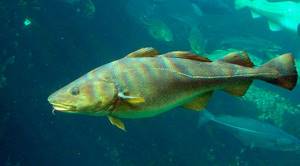
Listed in the Red Book due to its rarity. It is strictly forbidden to catch this fish; it is punishable by a fine. It feeds on mollusks. They go to spawn only after their weight reaches 4 kilograms, usually by the age of 10 years.
Pacific cod
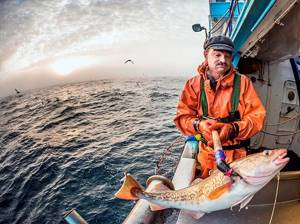
It differs from the above in size, which is up to one and a half meters. Life expectancy is only 10 years, during which this fish can produce fruit 2 times. They can eat navaga and pollock. The value is meat.

